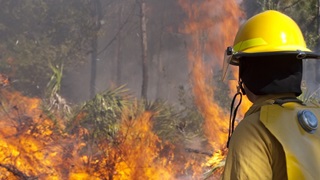Faux flames, electronic sensors, and the ‘real-life feel of a fire’
Digital fire training system helps Cornwall Fire Services battle real-life blazes
Practice may very well make perfect.
But in this line of work, practice is also potentially risky business.
“For years, firefighters have been training with real-live fire situations. We either use concrete buildings, which are costly and don’t have a very long shelf life, or real wood buildings, which is not good practice,” says Pierre Voisine, fire chief with Cornwall Fire Services in eastern Ontario.
“In either case, of course, it’s inherently dangerous. Even in a controlled manner, you can never fully predict what a fire’s going to do.”
In recent weeks, the safe solution to this dilemma arrived for the 64 firefighters with Cornwall Fire Services—a digital fire training system.
The $20,000 self-contained system has thermal sensors and self-generating digital flames. It can also be programmed to mimic a wood, electrical or oil-based blaze, and simulate the discharge of dry-chemical or carbon dioxide fire extinguishers.
It’s invaluable training for the front-line combatants with Cornwall Fire Services, who represent the busiest fire department in Ontario, says Voisine, and battle about 50 significant fires a year.
“It has the real-life feel of a fire—right down to detecting whether our firefighters have aligned our hose lines properly, and attacked the fire correctly,” he says. “It can be programmed to detect how much water or agent is needed before the fire starts fading away. A very handy tool.”
Enbridge’s Safe Community program was established in 2002 to support the emergency responders who protect the neighbors near our pipelines and facilities. We’ve invested about $9.3 million in equipment, training and education for emergency response organizations in North America, and that includes a recent $10,000 donation to Cornwall Fire Services to help purchase its digital simulator.
“As far as I’m concerned, Enbridge’s donation paid for this tool,” says Voisine. “We want to adapt new tactics, and the only way to do that is work them out through training with realism.
“That’s what this tool is going to do.”










